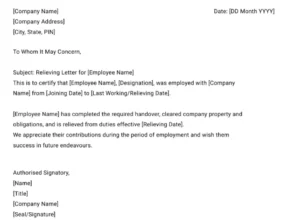Introduction
Switching jobs can be exciting, but it also comes with paperwork that determines how smoothly the transition unfolds. Among these, a letter of relief is one of the most important documents. Many employees often search for what a relieving letter is or what it means, as it is required to join a new organization. A relieving letter is an official document given by the employer to the employee, confirming that the employee has completed all exit formalities, served their notice period, and paid dues, if any. This blog delves into the meaning, importance, format, and difference between a relieving letter and an experience letter.
Why a Relieving Letter Matters for Employees
Job change is an important chapter in one’s career. To ensure a smooth transition, the documentation aspect is pivotal. One such document is a relieving letter. For an employee, obtaining this document is as important as receiving the final settlement, as it directly impacts the employee’s eligibility to join a new company. Many employers require a relieving letter during background verification, and it is often treated as mandatory.
Some people equate a relieving letter with a service letter, but they differ. The major distinction is that a service letter is a summary of the entire experience; on the contrary, a relieving letter is issued only at resignation. It formally confirms there are no pending dues and that the employee has been relieved of duties. In some organizations, it is also called a release letter.
Let’s look at why this document holds so much importance for employees.
1. Proof of Formal Resignation
The relieving letter is proof that the employee formally resigned and the organization accepted the resignation. This prevents any late contention and claims that the resignation was involuntary or termination-based.
2. Lenient Job Transition
Ordinarily, relieving letters are demanded from new employees before they are allowed to join the organization. If it is not provided, then a prospective institution may postpone the onboarding of the candidate or reject the candidate altogether. Hence, the document facilitates a smoother transition between jobs.
3. Evidence of Employment
A relieving letter, just like a service letter, is another piece of evidence that declares someone to have been employed by a company. Usually, it provides the joining and exit dates from employment, which is the crux of any background verification.
4. Assurance for the New Employer
This document also creates assurance for the new employer that the candidate does not have any obligations with the former organization that remain undischarged. This strengthens the credibility of the candidate, demonstrating professional integrity.
5. Preventing Legal or Compliance Issues
In certain industries, especially banking, finance, and IT, it is required for the compliance team to check if a relieving letter is issued. The absence of this can raise issues during audits or internal verifications.
Relieving Letter Format
While preparing a relieving letter format, the HR team should ideally include all details to avoid ambiguity and ensure clarity. If a letter is drafted according to this format, it usually carries the very intent with none of the ambiguities that might cause any disputes or could possibly further detract from a professional outlook. Many organizations also refer to this relieving letter format as a relieving order format.
The following are must-haves in any relieving letter:
1. Employee’s Full Name Along With Designation
The document has to clearly state the name of the employee as officially registered in company records and their last held designation. This is essential for ensuring that the letter is consistent with the employment record and thus cannot be disputed later.
2. Date of Joining and Date of Leaving
The relieving letter contains the date of joining as well as the date on which the employee’s last working day occurs. These dates become important during background verification, and there is a great chance that the new employer will cross-check them against their records.
3. Confirmation of Resignation Acceptance
Explicit language inside the letter indicates that the organization has accepted the resignation of the employee. This serves as evidence that the exit was voluntary and both parties-the departing employee and the employer-had agreed upon it.
4. Completion of Handover and Clearance
One important aspect of a relieving letter is the confirmation that the employee has done all the handover work and dues clearance. This confirms that no pending assignments or liabilities remain.
5. Thanking the Employee
Some companies include a brief, courteous comment expressing thanks to the employee for their service. It acts as an added goodwill gesture that promotes positive relationships.
6. Official Seal and Signature
To validate the relieving letter, issue it on the company letterhead and have it signed by an authorized signatory. A company seal may be added where applicable

Common Mistakes and Misunderstandings
1. Spelling Errors – “Releaving” Vs. “Relieving”
A common problem is making a query or writing a relieving letter when the standard term is ‘relieving letter.’ Such errors make the record inconsistent. It is therefore the responsibility of the HR team to cross-check the spelling before the issuance of the letter.
2. Mistaking a Relieving Letter for a Service Letter
Employees tend to confuse a service letter with a relieving letter. While both act as employment proofs, the service letter is an overview of tenure, whereas the relieving letter certifies that the employee has been officially released from duties.
3. Using Inconsistent Templates
Without a proper relieving order format, the documents would miss out on important details or may look inconsistent. A standardized format provides clarity and avoids disputes.
4. Missing Out on Essentials
There are times when HR forgets to put in the start date, the last working day, or the acceptance of resignation. Leaving any of these out would reduce the credibility of the document and may further cause complications in background verification.
5. Delay in Issuance of the Letter
Other common mistakes include delaying the issuance of the relieving letter. Such a document, when not timely provided, may stunt the onset of the employee’s journey in a new job.
6. Informal Tone
A relieving letter is an official document. Using informal or vague phrases, rather than professional formal language, may demean its value and create reciprocal confusion for both employees and future employers.
Relieving Letter vs Experience Letter
While both documents look similar, they serve different purposes. Many employees confuse the two and often search for an experience vs a relieving letter. Let’s break it down:
Aspect |
Relieving Letter |
Experience Letter |
|---|---|---|
Purpose |
Confirms that the employee has resigned, completed the notice period, and been officially released from duties. Acts as proof of clearance. |
Highlights the employee’s work history, roles, responsibilities, skills, and contributions during their tenure. Serves as a career reference. |
Timings of Issue |
Issued after resignation and completion of all exit formalities. |
Issued after the employee’s last working day or shortly thereafter. |
Content |
Includes employee’s name, designation, employment dates, confirmation of resignation acceptance, completion of handover, clearance of dues, and gratitude note. |
Includes employee’s name, designation, department, tenure, major responsibilities, achievements, and skills along with a formal letter of appreciation. |
Relation to Service Letter |
Sometimes called a release letter or relieving certificate, focuses on exit confirmation. |
Sometimes called a service letter, it focuses on work experience and achievements. |
Tone & Style |
Formal, concise, and administrative. |
Career-oriented terms and appreciation with a bit more description. |
What is an Experience Letter? Meaning and Importance
Professionals often search for relieving letters and also ask about experience letters, as they provide proof of a candidate’s professional career. An experience letter is a formal document issued by an employer, summarizing an employee’s tenure, designation, key duties, and contributions.
A relieving letter confirms that one has given notice, served a notice period, and has completed all exit formalities, whereas an experience letter states that someone has worked in a company but does not mention notice period or clearance status. Usually, it is issued to an employee on his or her last working day or shortly thereafter, and it will serve as an important record for a future job application, higher education registration, or immigration purposes.
A typical experience letter includes the employee’s full name, designation, department, tenure, and a brief description of key responsibilities, the department in which he has worked, his period of tenure, and a summary description of duties entrusted to him. Many organizations will also include comments intended by the reporting manager about an employee’s performance, skills, and achievements, along with a concluding, complementary note.
Some records authenticate the employee’s designation, while other details accentuate the individual’s professional standing to help the prospective employer determine whether the person is suitable for a new position. An experience letter can also be called a service letter in some organizations and regions. However, formally, the letter endorses the professional experience and credibility of the employee. Having a well-written experience letter in his career portfolio translates into a lot for the employee.
On the other hand, an experience letter is a true gesture of goodwill and a professional courtesy on the part of the employer. Such a letter ultimately bridges an employee’s past employment with their future opportunities, thereby lending clarity and acceptance to their career.
Experience Letter Format
An experience letter format issued in the right way becomes paramount to the interests of the employee and the employer alike. The letter acts as the employee’s proof of working skills, knowledge, or contribution, and is generally requested by the employee while being a party to his new appointment or higher academics. The experience letter issued by the employer must always establish its credibility and goodwill. While HR professionals try to understand how to draft experience letters, they should include every important detail to keep the document credible and informative. Below is the list of components to be incorporated into an Experience Letter for the employees:
Official Letterhead of the Company
Experience letters shall always carry the company’s official letterhead. This legitimizes the document such that it is accepted by the future employer, an institute, or a government authority.
Designation and Department
The letter contains the particular designation held by the employee and the department in which he was employed. This, in turn, gives future employers clarity on what the employee actually did and the level at which he did it.
Date of Joining and Relieving
The employee’s date of joining and relieving should be clearly mentioned. This establishes the employee’s period of employment and also confirms that the employee has completed the tenure with the organization.
Key Skills and Achievements
Point out the employee’s key core skills, contributions, and achievements during his/her tenure with your organization. This brings out the strengths and professional abilities of the employee, which help the prospective employers in assessing the suitability for their requirements.
Job Responsibilities
The statements should detail the most important duties and responsibilities of the employee. Care should be exercised not to elaborate on them too much, to avoid making the letter unnecessarily lengthy.
Closing Remarks
A formal closing statement should conclude the letter, appreciating the efforts and contributions of the employee. This is kept so the letter ends on a professional and positive note.
Authorized Signatories
This letter has to be countersigned by the HR manager or any authorized signatory. The name and designation of the person are to be mentioned, along with the company seal to validate the letter officially.
Are a Relieving Letter and a Service Letter the Same?
A Relieving Letter is often confused with a service letter by professionals; however, while both are official documents issued by employers, they serve different purposes and should not be treated as the same. A service letter gives general information about an employee’s tenure, designation, department, and general work record. It is more general and sometimes can even be issued when the employee is still in service, acting as proof of a legitimate professional relationship.
On the other hand, in the case of a relieving letter, it is limited and specific to the resignation or separation of an employee. In a way, the letter confirms formally that the employee has completed all exit formalities like handing over of responsibilities, clearance from dues, submitting company property, etc., thus officially discharging them from their duties. This subject-that the employee has no pending obligations-from the relieving letter allows the former employee to join a new organization without posing any problem, legally or administratively. Although some organizations might employ combined service letter formats or incorporate portions of both documents into one form, it is still considered best practice to issue these documents separately. With this differentiation, an employee remains clear of any confusion, hence allowing smooth background verification from future employers and maintaining the professionalism of the organization.
Conclusion
The relieving letter and experience letter both hold significant levels of importance for the professional lives of an employee. An employee’s relieving letter or release letter confirms the completion of exit formalities from an establishment. On the other hand, the experience letter or service letter document portrays the work history and accomplishments of an employee. When exiting a company, an employee should ensure that they receive both documents. On the other side, the organization ought to uphold the templates of the relieving order and the experience letter consistently. The knowledge of the purpose and actual format would establish confidence and smooth career transitions, benefitting employee and employer alike on the level of professional credibility.








